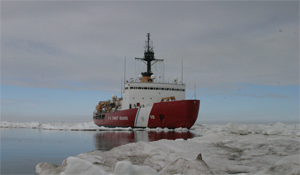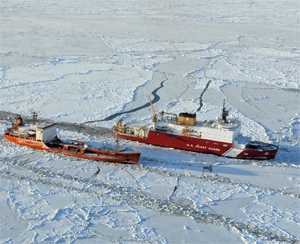The U.S. Coast Guard has announced plans to acquire two new heavy icebreakers to provide year-round access in the Arctic and Antarctic regions. Each vessel is expected to cost approximately $1 billion.
Coast Guard officials planned to meet with interested companies during Polar Icebreaker Industry Day on March 18 in McLean, Va. More than 200 participants had registered by early March, according to Brian Olexy, assistant commandant for acquisition for the Coast Guard’s Office of Strategic Planning and Communication.
The U.S. currently has only one operational heavy icebreaker, Polar Star, which was commissioned in 1976. Its 18,000-hp diesel engines and 75,000-hp gas turbines can power the 399-foot ship through ice up to 21 feet thick. It can break through 6 feet of ice at a continuous speed of 3 knots.
The ship is used to clear paths for cargo ships, free vessels stuck in the ice and supply researchers at the McMurdo Station in the Ross Sea.
A second heavy icebreaker, Polar Sea, which was commissioned in 1978, suffered a massive engine failure in 2010 and has since been inactive, often being used to supply parts for Polar Star. The cutter Healy, which can break ice 8 feet thick by ramming and 4.5 feet thick at a continuous speed of 3 knots, also operates in the Arctic and Antarctic regions.
 |
|
The icebreaker Polar Sea clears a path in the Arctic Ocean in support of scientific projects in 2009. The ship is currently mothballed due to engine failure. |
|
Courtesy U.S. Coast Guard |
“Two vessels provide some self-rescue capability if one encounters a problem or becomes beset in ice,” Olexy said. The Coast Guard’s remaining icebreakers — the cutter Mackinaw and nine 140-foot icebreaking tugs — are designed for operations in the northeastern U.S. and the Great Lakes.
In September, President Obama called for the acquisition of at least one new heavy icebreaker by 2020, earlier than the previous goal of 2022. A statement released by the White House said the administration would call on Congress to provide sufficient resources for the investment.
“These heavy icebreakers will ensure that the United States can meet our national interests, protect and manage our natural resources, and strengthen our international, state, local and tribal relationships,” the statement read.
The president’s 2017 budget requests $150 million to complete planning and support the award of a design contract.
The Coast Guard has released notional requirements for the vessels, which include the ability to break through at least 6 feet of ice at a continuous speed of 3 knots and 21 feet of ice by ramming; the ability to operate for 80 days without food or fuel replenishment; and the ability to hangar two aircraft.
 |
|
Polar Star conducts ice drills in the Arctic in 2013. |
|
Courtesy U.S. Coast Guard |
Olexy expects the contract to be awarded in 2019. He said it would take about eight more years before the vessels are fully operational.
A wide variety of designers, suppliers and shipbuilders including General Dynamics and Huntington Ingalls Industries have expressed interest in the project, according to the Coast Guard.
“We built the last icebreaker, Healy, and given all the platforms we design and build, we believe we could support the Coast Guard with an affordable, low-risk and very capable option,” said Huntington Ingalls Industries spokesman Bill Glenn.
A General Dynamics spokesman said the company was assessing the information provided by the Coast Guard.

